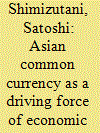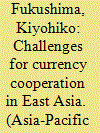| Srl | Item |
| 1 |
ID:
092145


|
|
|
|
|
| Publication |
2009.
|
| Summary/Abstract |
This article proposes an open and multi-tiered economic and financial system with introduction of an Asian common currency as a form for the Post Bretton-Woods arrangement. After reviewing the role of the incumbent international economic system, the reasons that an Asian common currency could contribute to consolidate the new international system is discussed bearing in mind the new environment of the relative decline of economic power of the United States and relative rise of economic power of China. Then a "roadmap" for the introduction of an Asian common currency is provided and how to proceed steadily on the long road towards the introduction of the new currency is argued. In particular, it is emphasized, as the world looks for a new direction, that strong political collaboration in the region is required precisely now with a view to making this a reality.
|
|
|
|
|
|
|
|
|
|
|
|
|
|
|
|
| 2 |
ID:
051898


|
|
|
|
|
| Publication |
May 2004.
|
| Summary/Abstract |
The defects of the current international financial system are creating tremendous distortions in the economies of East Asia. For the time being, most of the developing countries in East Asia have no choice but to adopt some sort of a flexible, wider band system (crawling band) while resorting to capital control when necessary, in order to avoid the recurrence of the Asian currency crisis.
Japan's approach to building a stable international financial system in East Asia has gone through several stages since the late 1970s. Though the latest approach of setting up the Asian Bond Fund (ABF) is a step in the right direction, the ABF has severe limitations in reducing the risks for the developing countries in Asia. The ABF needs to be replaced by the Asian Bond Corporation (ABC) in order to develop an international capital market in Asia and use the abundant saving in Asia for financing the growth of Asia. In the process of expanding the activities of the ABC, Asia can adopt the notional common currency based on a basket of major currencies. That notional currency will pave the way toward introducing the Asian common currency, which can be the ultimate goal for the economic cooperation and integration in East Asia.
In the meantime, while enhancing currency cooperation, East Asia needs a lender of the last resort in order to keep its economy from collapsing from another currency attack. Japan has been trying to play that role and is poised to take that responsibility as the largest and the most developed economy in the region.
International capital markets and a truly international currency must be supported by numerous institutions and intellectual frameworks. Asia is yet to build those institutions. To help build those institutions, we in East Asia need to establish a new international research institution which would coordinate the strenuous intellectual efforts needed for building institutions that bolster the international capital market in Asia. The envisaged new institute can be dubbed the "Asian Monetary Institute," or "AMI."
|
|
|
|
|
|
|
|
|
|
|
|
|
|
|
|